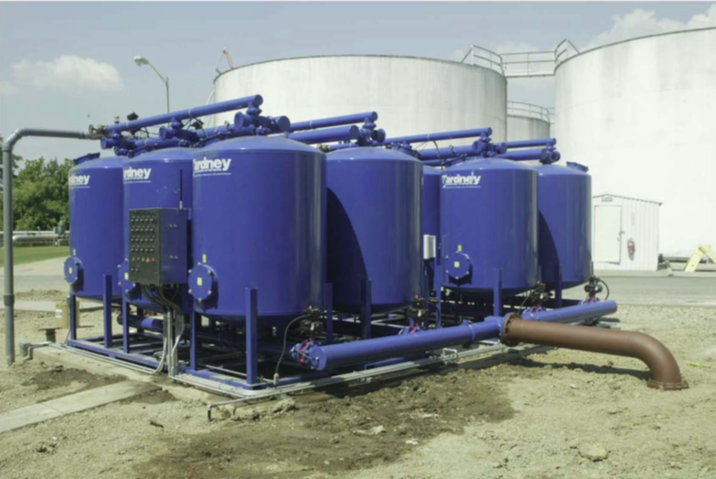Water Treatment Cooling Towers & Boilers: All natural waters contain varying amounts of suspended and dissolved matter as well as dissolved gases. The type and amount of impurities in fresh water vary with the source (lake, river, and well) and with the area of location. Impurities in water become an important consideration when water is to be used for steam generation. With the trend toward higher-pressure boilers, pretreatment has become the key to successful operation of industrial power plants. Feedwater must be pretreated to remove impurities to control deposition, carryover, and corrosion in the boiler system. Poor quality water gives poor quality steam.
Water-filtration systems in cooling towers increase the effectiveness of chemical treatment, which reduces chemical usage. Filtration also reduces the need for frequent tower cleaning and blowdown, and increases heat transfer efficiency. Iron and Manganese buildup in these systems significantly affect their performance.
Water evaporating in the boiler causes impurities to concentrate. Boiler scale results from suspended matter settling out on the metal or dissolved impurities precipitating out on heat transfer surfaces and becoming hard and adherent. Iron deposits are very dark coloured and are due to corrosion products or iron contamination in feedwater. Iron deposits are usually magnetic in nature. They are soluble in hot acid, giving a dark-brown solution.
The major problem that deposits cause is tube failure from overheating. This is due to the fact that the deposits act as an insulator and excessive deposits prevent efficient heat transfer through the tubes to the water. This causes the metal to become overheated and over time the metal fails. These deposits can also cause plugging or partial obstruction of boiler tubes, leading to starvation and subsequent overheating of the tubes. Underneath the deposit layer corrosion may also occur. Deposits cause unscheduled outages, increased cleaning time and expenses. Boiler deposits reduce overall operating efficiency resulting in higher fuel consumption.
DMI-65 is an extremely powerful silica sand based catalytic action water filtration media that is designed for the removal of Iron and Manganese without the use of potassium permanganate through an Advanced Oxidation Process. Incorporation of a DMI-65 filtration will materially reduce the symptoms as well as benefitting the total system by performing disinfection and mechanical filtration of undissolved solids. DMI-65 is infused technology and not just a surface coating technology, unlike other catalytic water filtration media, which removes the chance of any chemical leaching into the water stream.
In order to begin the process of oxidation of the iron (and manganese) in solution DMI-65 is designed to operate in the presence of chlorine or other oxidant. In this process the oxidant removes electrons and is consumed in the process. The operator needs to ensure that there is a 0.1 – 0.3 ppm free chlorine residual in the effluent water. Chlorine, fed as sodium hypochlorite or bleach (12.5% NaOCl), is the preferred oxidant since it is relatively inexpensive, readily available around the world and it is effective. It also performs the vast majority of any disinfectant process.
Unlike ion exchange resins where higher regenerant dosages will increase the ion exchange capacity, NaOCl residuals or concentrations higher than required to oxidize the Fe and Mn do not increase the oxidative properties of the media. Additionally, since the media is often used to pretreat waters prior to an RO system a higher free chlorine residual would require more extensive post treatment to reduce the residual and protect the membranes from chlorine attack.
DMI-65 has been certified to the US Standard of NSF/ANSI 61 for Drinking Water System Components and has been tested by many other water treatment laboratories
DMI-65 is manufactured in Australia.
Case History: Water Treatment for Cooling Towers & Boilers:
A food plant in Memphis, TN drilled a well to provide 1000 gpm of cooling tower and boiler make-up water. However, iron levels of 1.0 ppm restricted the use of the water for these services requiring the plant to purchase water from the city at a cost of $10,000 per month. In 2009 they installed a new filter system utilizing 576 ft3 of DMI-65. The system consists of twelve (12) 54” x 60” filter vessels operating at 5 gpm/ft2. Once the system was placed into service the Fe level was controlled at 0.01 ppm and the plant was able to discontinue the use of city water.
Advantages of using DMI-65 water treatment for cooling towers & boilers:
Iron and Manganese buildup. Build up of iron and manganese in boilers and cooling towers results in very high maintenance overheads, loss of production and potentially system failure. DMI-65 efficiently removes dissolved iron to the almost undetectable levels as low as 0.005 PPM and manganese to 0.001 PPM as well as particulate, effectively removing this risk.
Reduced Costs The total cost of the iron and manganese removal water filtration system is significantly less than alternative solutions, the effectiveness, but relative simplicity, of DMI-65 based systems reduces the upfront capital expenditure on plant complexity as well as the ongoing operational expenditure in chemicals, power and backwash waste water recovery.
High Flow Rates. The infused technology of DMI-65 promotes the highest oxidation rate of any catalytic filtration media. This permits a significantly higher water flow rate to achieve the same level of iron and manganese removal. DMI-65 can operate at linear filtration velocities up to twice that of conventional media with a corresponding reduction in capital equipment
High Load Capacity Because of the increased surface area due to the micro-porous structure of the matrix material, the DMI-65 also has higher iron and manganese load capacity which can extend the duration of filter runs and the time between backwashing, thereby reducing downtime, operating expense and wastage.
Regeneration Not Required. The media operates with a continuous injection of sodium hypochlorite at low residual levels (0.1 to 0.3 ppm) which eliminates the need for Potassium Permanganate.
Wide Operating Environment. Stable and satisfactory performance at pH 5.8 to 8.6 and a maximum operating temperature of 113° F (45°C) reduces the need for investment to alter the operating environment.
Long Life. DMI-65 is not consumed in the process giving it an expected operational life of up to 10 years, providing considerable advantages over other processes or media. The media does not display a decaying capacity to do its catalytic work. Over the 5 to 10 year period, through many backwashing operations of the bed to remove retained solids, an attrition loss of the media occurs by contact between particles and mechanical abrasion












